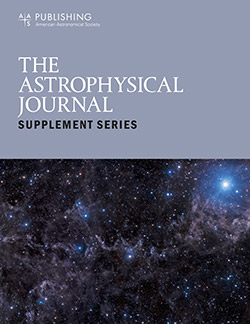日冕物质抛射源区目录及其相关性质
IF 8.5
1区 物理与天体物理
Q1 ASTRONOMY & ASTROPHYSICS
引用次数: 0
摘要
摘要本研究的主要目的是将日冕物质抛射(CME)与其源区域联系起来,建立CME源区域目录,并探讨源区域对CME不同统计特性的影响。我们创建了1998年至2017年3327次cme的源区域目录,从而捕获了周期23和24的不同阶段。已确定的源区域被分为三类——活跃区、日珥喷发区和活跃日珥区,而cme则根据其平均预测速度被分为慢速组和快速组。在上述时期,三种震源类型对快慢日冕物质抛射的贡献是不同的。对平均速度分布的研究表明,不同来源的日冕物质抛射有不同的幂律,在周期23和24的不同阶段的幂律也不同。对统计纬度偏转的研究显示出赤道偏转,而偏转的大小又有震源地区的印记。也注意到东西不对称,特别是在第23周期的上升阶段,存在活跃的日冕物质抛射经度,倾向于太阳的西部。我们的研究结果表明,CME运动学的不同方面具有它们起源区域的强烈印记,从而表明这些CME存在不同的喷射和/或传播机制。本文章由计算机程序翻译,如有差异,请以英文原文为准。
A Coronal Mass Ejection Source Region Catalog and Their Associated Properties
Abstract The primary objective of this study is to connect coronal mass ejections (CMEs) to their source regions, primarily to create a CME source region catalog, and secondarily to probe the influence that the source regions have on the different statistical properties of CMEs. We create a source region catalog for 3327 CMEs from 1998 to 2017, thus capturing the different phases of cycles 23 and 24. The identified source regions are segregated into three classes—active regions, prominence eruptions, and active prominences—while the CMEs are segregated into slow and fast groups, based on their average projected speeds. We find the contributions of these three source region types to the occurrences of slow and fast CMEs to be different in the above period. A study of the distribution of the average speeds reveals different power laws for CMEs originating from different sources, and the power laws are different during the different phases of cycles 23 and 24. A study of the statistical latitudinal deflections shows equatorward deflections, while the magnitudes of the deflections again bear imprints of the source regions. An east–west asymmetry is also noted, particularly in the rising phase of cycle 23, with the presence of active longitudes for the CMEs, with a preference toward the western part of the Sun. Our results show that different aspects of CME kinematics bear strong imprints of the source regions they originate from, thus indicating the existence of different ejection and/or propagation mechanisms of these CMEs.
求助全文
通过发布文献求助,成功后即可免费获取论文全文。
去求助
来源期刊

Astrophysical Journal Supplement Series
地学天文-天文与天体物理
CiteScore
14.50
自引率
5.70%
发文量
264
审稿时长
2 months
期刊介绍:
The Astrophysical Journal Supplement (ApJS) serves as an open-access journal that publishes significant articles featuring extensive data or calculations in the field of astrophysics. It also facilitates Special Issues, presenting thematically related papers simultaneously in a single volume.
 求助内容:
求助内容: 应助结果提醒方式:
应助结果提醒方式:


